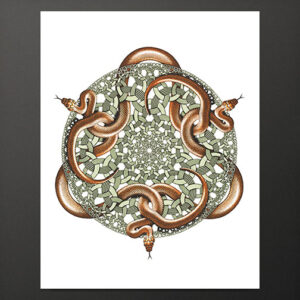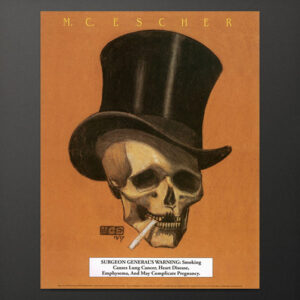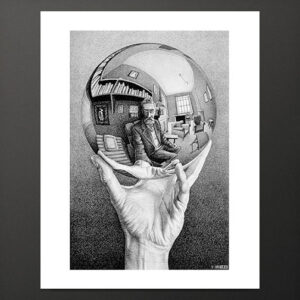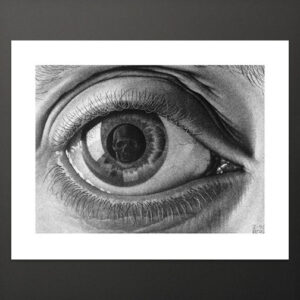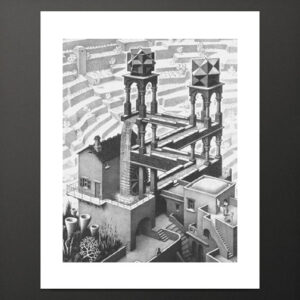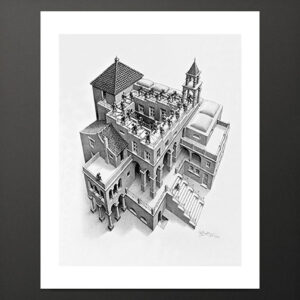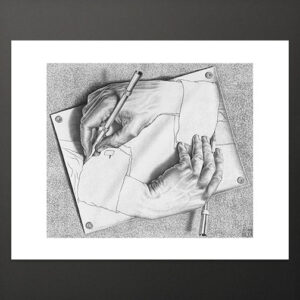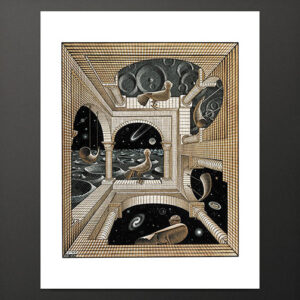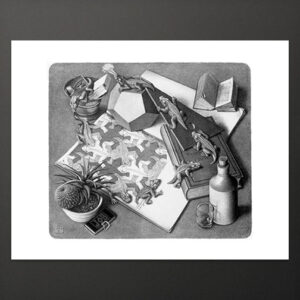-
M.C. Escher’s Snakes (1969) is one of his last and most intricate woodcut prints, showcasing his mastery of symmetry and infinite patterns. The artwork features interlocking snakes weaving through a circular design that appears to extend endlessly inward and outward. Using tessellation, perspective, and negative space, Escher creates a mesmerizing sense of depth and movement. This piece reflects his lifelong fascination with infinity, geometry, and order, making it a fitting culmination of his artistic exploration of mathematical concepts. Printed in color on poster paper. Packaged in cardboard tube. Poster size 35,5 x 28 cm, image size approx 27,5 x 24 cm.
-
Printed in color on poster paper. Packaged in cardboard tube. 35,5x28 cm
-
Hand with Reflecting Sphere, lithograph, 1935. "A reflective sphere rests on the hand of the draftsman. He sees a much more complete picture of his surroundings in that mirror than through direct observation, because he sees almost the entire space around him: four walls, floor and ceiling of his room are , albeit distorted, compressed into that disk. His head, more precisely: the point right between his eyes, is in the center. No matter how he turns, he remains the center ." ~ M.C. Escher, Grafiek en Tekeningen. Printed in black and white on poster paper. Packaged in cardboard tube. Poster size 35,5 x 28 cm, image size approx 28,4 x 19 cm.
-
Eye, mezzotint, 1946. "The artist has depicted his own eye here, greatly enlarged in a concave shaving mirror. The pupil reflects him who is looking at all of us." ~ M.C. Escher, Grafiek en Tekeningen. Printed in black and white on poster paper. Poster size 28 x 35,5 cm , image size approx 20,8 x 28 cm. Packaged in cardboard tube.
-
M.C. Escher’s Waterfall (1961) is a lithograph that defies the laws of physics through an impossible perpetual motion system. The artwork features a watercourse that appears to flow upward before cascading down a waterfall, which then feeds back into the same stream —creating an endless loop. Inspired by impossible objects like the Penrose triangle, Escher masterfully manipulates perspective and geometry to challenge our understanding of space and reality. Printed in black and white on poster paper. Poster size 35,5 x 28 cm, image size approx 25,5 x 20 cm. Packaged in cardboard tube.
-
M.C. Escher’s Ascending and Descending (1960) is a famous lithograph that plays with perspective and impossible geometry. The artwork features a never-ending staircase, inspired by the Penrose stairs, where figures appear to be endlessly walking up or down without making any progress. Escher’s meticulous use of mathematical illusion and architectural paradox challenges the viewer’s perception of reality. The piece is a hallmark of Escher’s fascination with infinity, order, and the limits of visual logic, making it one of his most thought-provoking works. Printed in black and white on poster paper. Packaged in cardboard tube. Poster size 35,5 x 28 cm, image size approx 28,5 x 22,6 cm.
-
M.C. Escher’s Drawing Hands (1948) is a mind-bending lithograph that explores the paradox of self-creation. The artwork depicts two hands emerging from a flat surface, each sketching the other into existence. With its intricate detail and clever use of shading, Escher blurs the line between art and reality, creating an illusion that defies logic. This piece is a striking example of his fascination with self-reference, recursion, and the interplay between two-dimensional and three-dimensional space, making it one of his most iconic and thought-provoking works. Printed in black and white on poster paper. Poster size 35,5 x 28 cm, image size approx 23 x 19,5 cm. Packaged in cardboard tube.
-
M.C. Escher’s Other World (1947) is a fascinating wood engraving that distorts perspective to create a surreal, multidimensional space. The artwork depicts an alien-like architectural structure with arches and columns, where the laws of gravity seem to shift depending on the viewer’s perspective. The sky, ground, and walls seamlessly blend, making it unclear which direction is "up" or "down." This piece exemplifies Escher’s mastery of impossible spaces, optical illusions, and altered perception, drawing viewers into a world where logic and reality are playfully subverted. Printed in color on poster paper. Packaged in cardboard tube. Poster size 35,5 x 28 cm, image size approx 27,6 x 22,6 cm.
-
*M.C. Escher’s Reptiles (1943) is a whimsical yet thought-provoking lithograph that blends two-dimensional patterns with three-dimensional reality. The artwork depicts small, tessellated reptiles crawling out of a flat, geometric drawing, coming to life as they march across various objects before re-entering the paper. This seamless transition between dimensions showcases Escher’s fascination with optical illusions, metamorphosis, and the interplay between art and reality. Printed in black and white on poster paper. Poster size 28 x 35,5 cm, image size approx 20 x 23 cm. Packaged in cardboard tube.
-
M.C. Escher’s Three Worlds (1955) is a captivating lithograph that explores different layers of reality within a single image. The artwork depicts a pond’s surface reflecting the bare branches of trees (the first world), while a fish swims beneath the water (the second world), and fallen leaves float on the surface (the third world). Through this composition, Escher masterfully plays with perspective, reflection, and transparency, creating a poetic and thought-provoking meditation on perception and the coexistence of multiple realities. Printed in black and white on poster paper. Packaged in cardboard tube. Poster size 35,5 x 28, imgae size approx 27 x 18,5 cm.

